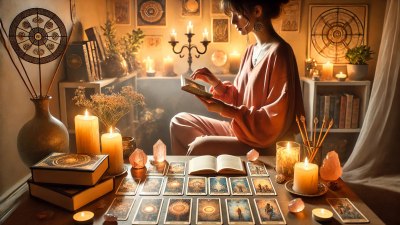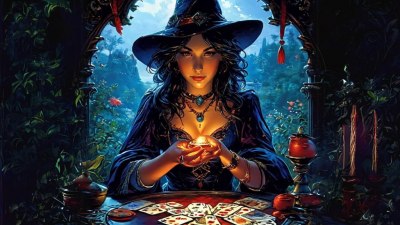The History of Fortune Telling: From Crystal Balls to Tarot Cards 🔮🃏
Explore the rich history of fortune telling, from ancient divination methods like scrying and palmistry to modern-day tarot card readings. Discover how these mystical tools have evolved and their enduring appeal today!

This image was created with the assistance of Playground AI
Fortune telling has intrigued people for centuries, offering a glimpse into the unknown and the possibility of uncovering future events. From ancient times to modern practices, the art of divination has evolved, yet the desire to peer into the mysteries of life remains the same.
Whether through the mystical gaze of a crystal ball, the symbolic imagery of tarot cards, or other esoteric methods, fortune telling has played a fascinating role in cultures around the world. Let’s take a journey through the history of fortune telling and explore how these timeless practices have evolved.
Early Beginnings: The Roots of Divination 🌿
Fortune telling, or divination, dates back thousands of years, with the earliest forms rooted in ancient civilizations. These early methods weren’t about predicting the future as much as they were about understanding the will of the gods or interpreting natural events as signs.
1. Ancient Mesopotamia (c. 4000 BCE)
One of the earliest known forms of divination comes from ancient Mesopotamia, where people believed that gods communicated through nature. By studying the patterns of animal entrails (known as haruspicy) or observing clouds, birds, and stars, Mesopotamian priests would interpret divine messages. These methods were used to advise kings and warriors on important matters like war, harvests, and health.
2. Ancient China
In ancient China, oracle bones were one of the first methods of fortune telling. Diviners would inscribe questions onto animal bones or turtle shells, then heat them until they cracked. The cracks would then be interpreted to answer questions about the future or seek advice from ancestors. This practice, known as pyromancy, was central to early Chinese spirituality and decision-making.
3. Egyptian and Greek Traditions
Both the ancient Egyptians and Greeks believed that the gods communicated through dreams, omens, and natural events. In Egypt, priests would interpret the movements of the stars and planets for divine guidance. The Greeks used methods like astrology and oracles, such as the famous Oracle of Delphi, where priestesses would deliver cryptic prophecies inspired by the god Apollo.
The Rise of Mystical Tools: From Scrying to Cards 🔮🃏
As time passed, fortune telling evolved to include specific tools that could aid in divination. These mystical objects helped fortune tellers connect with unseen forces or gain insights into future events.
1. Crystal Balls: The Art of Scrying 🔮
The image of a fortune teller gazing into a crystal ball is iconic, but scrying, the act of looking into reflective surfaces for visions, is a much older practice. Scrying can be done using various reflective surfaces, such as water, mirrors, or polished stones, and dates back to ancient civilizations like the Egyptians, Celts, and Mayans.
- Crystal Balls: By the Middle Ages, crystal balls became the preferred tool for scrying. Fortune tellers would gaze into the crystal, hoping to see images or symbols that could reveal hidden truths or future events. The ball itself was seen as a powerful object, capable of channeling psychic energy and connecting the seer with otherworldly forces.
Fun fact: Nostradamus, the famous 16th-century seer, was believed to have used a bowl of water for scrying to produce his famous prophecies.
2. Palmistry: Reading the Lines of Fate ✋
Another ancient form of divination, palmistry (also known as chiromancy), involves reading the lines and shapes of the hands to reveal a person’s character, life path, and future events. This practice has its roots in India, where it was linked to Hindu astrology. From India, palmistry spread to China, Greece, and throughout Europe.
- Palmistry in the Renaissance: During the Renaissance, palmistry gained popularity in Europe as scholars and mystics sought to connect the lines on the palm with the movements of celestial bodies. People believed that the hand’s unique markings held clues to their destiny, and palm reading became a respected art in fortune-telling circles.
3. Tarot Cards: The Evolution of Symbolic Divination 🃏
Perhaps one of the most recognizable tools in modern fortune telling is the tarot deck. Tarot cards, with their rich symbolism and mysterious imagery, have become a staple in divination, offering insight into both the present and the future.
- Origins of Tarot: The origins of tarot cards are somewhat murky, but they likely began as playing cards in 14th-century Italy. These early tarot decks were known as tarocchi and were used for games, not divination. Over time, mystics began to assign deeper meanings to the cards, linking them with spiritual symbolism and the occult.
- Tarot and Mysticism: By the 18th century, tarot cards had become popular tools for divination, with mystics such as Jean-Baptiste Alliette (known as Etteilla) creating the first tarot deck designed specifically for fortune telling. Tarot was soon adopted by the Hermetic Order of the Golden Dawn, an occult society that used tarot for spiritual guidance and self-discovery.
Today, the Rider-Waite Tarot deck, first published in 1909, is one of the most popular and widely recognized tarot decks. Each card, from the Fool to the Tower, carries its own symbolism, offering insight into a range of life experiences—from love and relationships to challenges and personal growth.
The Evolution of Fortune Telling in the Modern Era ✨
By the 19th and 20th centuries, fortune telling had transformed from a mystical art practiced by priests and scholars into a more accessible, everyday practice for people seeking guidance.
1. Astrology: Mapping the Stars 🌌
While astrology dates back thousands of years to the Babylonians, it saw a resurgence in the 20th century as people began seeking guidance based on their zodiac signs and planetary alignments. Horoscopes became popular features in newspapers and magazines, allowing people to gain daily insights based on their birth charts. Today, astrology remains one of the most popular forms of divination, helping people understand everything from love compatibility to career paths.
2. Psychic Readings and Mediums 🔮
In the 19th century, the spiritualist movement took hold, particularly in the United States and Europe. Mediums claimed to communicate with spirits, offering messages from loved ones who had passed away. This period saw a rise in seances and psychic readings, where individuals sought guidance from the spirit world on matters of life and death.
Today, psychic readings remain popular, with people turning to psychics for answers about love, career, and the future. Many psychics use tools like tarot cards, crystal balls, or simply their own intuitive abilities.
Fortune Telling Today: A Blend of Tradition and Modernity 🌟
In the modern world, fortune telling is more accessible than ever. Whether through tarot readings, astrological charts, or crystal healing, people continue to seek guidance from these ancient practices in navigating the complexities of life. The digital age has also brought fortune telling online, allowing people to connect with readers through apps, websites, and virtual sessions.
Though the tools and methods may have evolved, the core purpose remains the same: to understand our place in the universe and gain insight into the unknown.
The Timeless Appeal of Fortune Telling 🔮🃏
From ancient divination practices in Mesopotamia to modern tarot readings, fortune telling has woven itself into the fabric of human history. Whether you’re drawn to crystal balls, palmistry, or the mystical symbolism of tarot, these practices offer a timeless way to explore your future and connect with the mysteries of life. As we continue to evolve, so too does our fascination with the unseen, ensuring that fortune telling remains a compelling and cherished tradition.
































